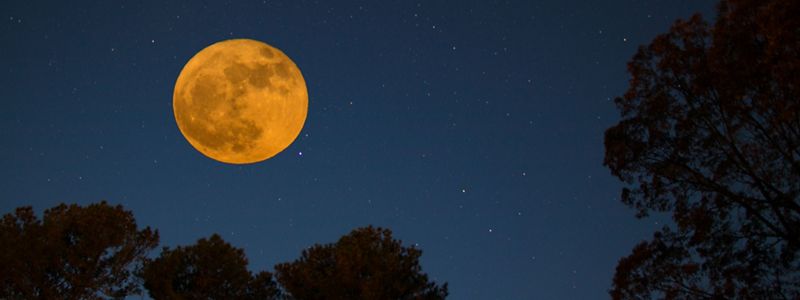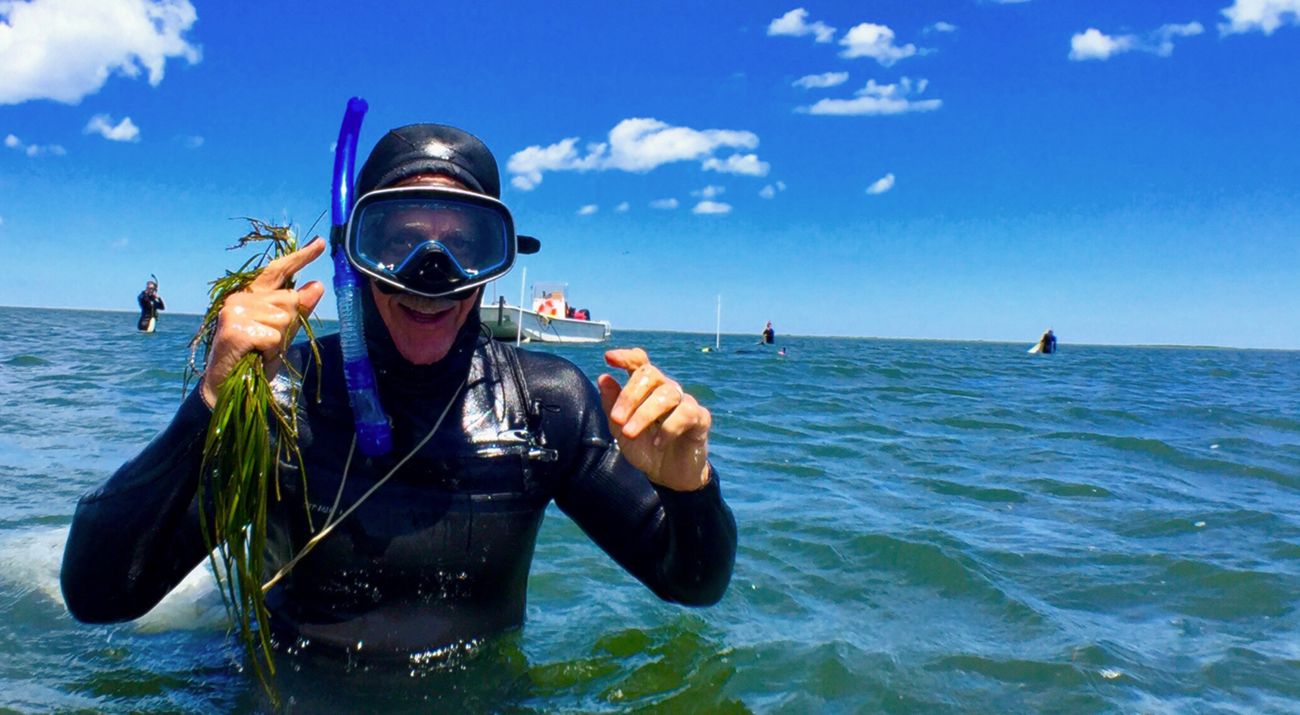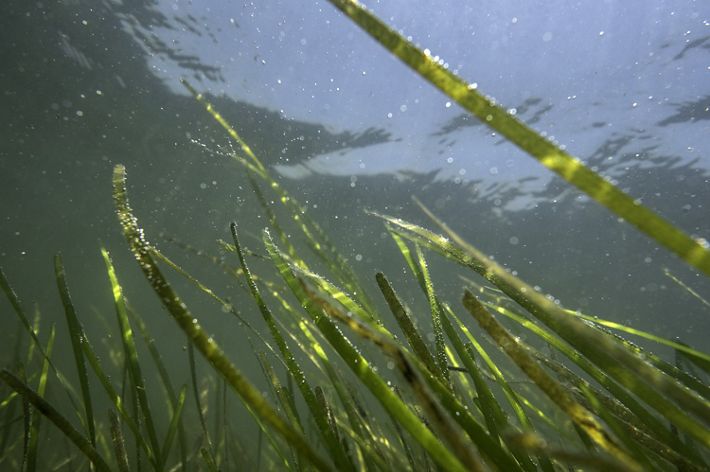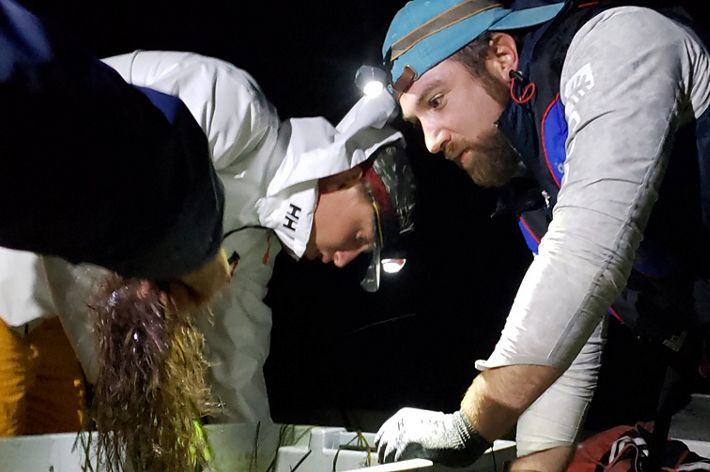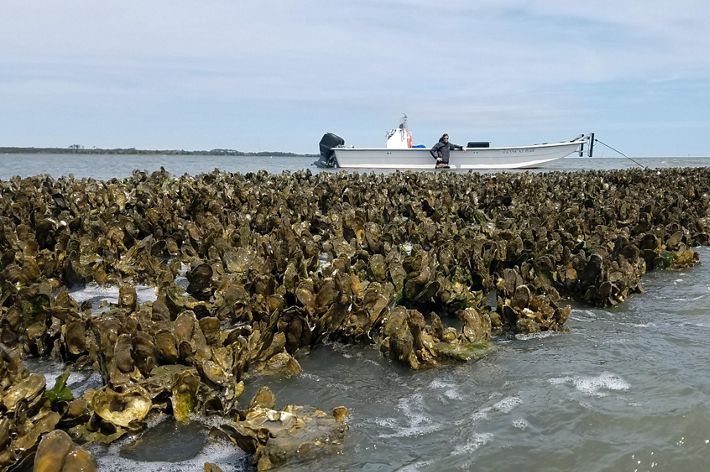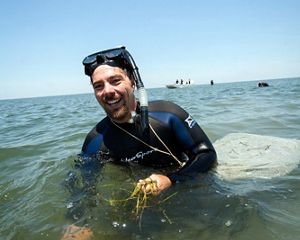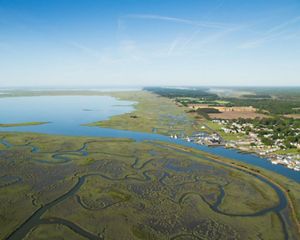Marine Habitat Restoration
The Volgenau Virginia Coast Reserve is putting science to work in Virginia's coastal bays.
Healthy natural communities can make a difference in people’s lives, especially in places like Virginia's Eastern Shore that are vulnerable to rising seas and the more frequent and intense storms associated with climate change.
That’s why we’re riding a wave of restoration at the Volgenau Virginia Coast Reserve.
Restoring Seagrass
In the early 1930s, a noxious slime mold and the powerful Chesapeake-Potomac Hurricane combined to devastate seagrass meadows in Virginia’s coastal bays. While seagrasses did regenerate in the Chesapeake, they never returned to Virginia's other coastal bays.
As one species—eelgrass (Zostera marina)—collapsed, it created a ripple effect. With the loss of this critical nursery habitat, commercially important bay scallops completely disappeared from Virginia’s waters. Other marine animals—from blue crabs to seahorses and striped bass—became refugees.
A patch of eelgrass was discovered in 1999 in a seaside bay off the Eastern Shore. It may have taken root from seeds that had drifted down from Chincoteague Bay. According to Dr. Robert "JJ" Orth from the Virginia Institute of Marine Science (VIMS), "That’s when the light went on that conditions there might be ripe for recovery, as long as there was a source of seeds."
Each spring since 2008, 40 to 60 volunteers have signed on to boost the now decades-long partnership. Volunteer snorkelers collect reproductive shoots containing ripe seeds from the underwater plants. The shoots are measured into water tanks where the seeds are then cured, separated, and prepared for fall planting.
Starting from the mere remnant Orth located nearby, VIMS and TNC have since broadcast more than 72 million seeds into 600 acres to help accelerate the natural spread of eelgrass, which now covers more than 9,500 acres (and counting!) in South, Spider Crab, Hog Island and Cobb Island bays.
An exciting discovery was made in the seagrass meadows in 2021—surprising numbers of American eels (Anguilla rostrata). Over many summers, VVCR staff members have worked with VIMS to conduct monthly fish trawls in the restored eelgrass beds. Data from these trawls has shown an explosion of fish biomass in Virginia's coastal bays in the restored habitat. In the summer of 2021, trawls were conducted for the first time after dark in addition to the usual daytime sampling. The eels were found during the nighttime surveys and seem to indicate that the seaside eelgrass meadows may support a significant population. As eels are mostly nocturnal, they are likely spending the day hiding in burrows under the eelgrass.
Mitigating Climate Change
Seagrass beds also have a role to play in mitigating the impacts of climate change. Five acres of eelgrass can soak up enough carbon dioxide to offset driving a car 15,000 miles a year. According to a 2012 study by Florida International University, coastal seagrass can store more than twice as much carbon per square kilometer as terrestrial forests.
And results from the long-term monitoring of Virginia's restored eelgrass published in 2020 indicates that storage capacity increases as the meadows mature. Seagrass plots in place for nine or more years stored, on average, 1.3 times more carbon and 2.2 times more nitrogen than younger plots.
If you have questions or concerns regarding our blue carbon seagrass project, please contact Jill Bieri, Volgenau Virginia Coast Reserve Program Director, by phone at 757-442-5416 or email jbieri@tnc.org.
Quote: Dr. Robert "JJ" Orth
Our work in Virginia's coastal bays is a blueprint for restoring and maintaining healthy ecosystems to safeguard multiple benefits as we move into an uncertain future.
Oyster Reef Restoration
Oyster restoration has long been a priority for TNC. Oysters filter sediment and algae and remove nitrogen from the water, while their reefs provide nurseries and feeding grounds for rockfish, crabs and other marine life. For generations, oysters have played an important role in Virginia’s economy.
Oyster reef restoration also offers a nature-based solution for adapting to climate change. Reefs can take the punch out of storm waves and help slow the rate of erosion along marsh edges. As they grow, oyster reefs accrete vertically, keeping pace with sea level rise and increasing their capacity for storm protection.
The Eastern Shore's unique expanse of Atlantic coastal wilderness offers unparalleled opportunities to study how local communities can benefit from intact natural systems, and the advantages of restoring coastal habitat.
Pearls of Hope
Restored oyster reefs match multiple functions of natural reefs within a decade.
Study ResultsIn April 2022, researchers from the University of Virginia, working in partnership with TNC, published the results of a 15-year study that offers hope for the bivalve's future. Looking at 16 sites composed of 70 reefs, the study demonstrates that restored reefs can match natural reef oyster populations in about six years and continue to hold strong thereafter. The study also concludes that the ecosystem benefits that restored reefs provide can catch up within a decade—meaning cleaner and clearer water as well as habitat that supports coastal fisheries.
What makes for a successful oyster reef? And where is the “sweet spot” for oysters to survive and thrive? These are questions being addressed in another study conducted by Virginia SeaGrant and UVA Ph.D. candidate Kinsey Tedford.
Working with TNC Coastal Scientist Bo Lusk, Kinsey is monitoring 18 oyster reefs at the Volgenau Virginia Coast Reserve, taking detailed measurements for elevation, oyster growth and reef structure, to see what conditions are most important to optimize reef survival and growth. The results of this study will help inform TNC's long-term restoration efforts.
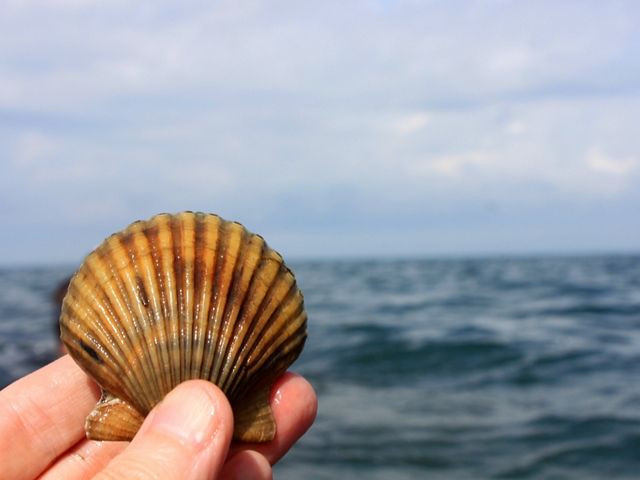
Bay Scallops
Virginia supported the most productive bay scallop (Argopecten irradians) fishery in the United States in 1930, but the scallops disappeared along with the seagrass meadows. In 1933, Virginia watermen harvested no bay scallops at all.
But after more than 80 years, the tide may be turning. Along with our partners at VIMS, we’re working to build on our successful eelgrass restoration efforts by returning bay scallops to Virginia waters.
VVCR Coastal Scientist Bo Lusk assisted VIMS in releasing the first test batch of 5,500 juvenile bay scallops on August 4, 2009 in a seagrass meadow in South Bay. Scallops affix themselves to blades of seagrass which provide shelter from strong currents and from predators like crabs and rays.
We have begun working with VIMS on several projects, including an effort to produce and grow scallops from larvae to juvenile size. 3 million of VIMS’ bay scallop larvae are currently being raised in TNC setting tanks. In May 2017, we released 12.3 million bay scallop larvae that were spawned by VIMS and Cherrystone Aquafarms into the eelgrass in South Bay. The hope is to eventually restore a self-sustaining population of bay scallops to Virginia waters.
“One of the most rewarding things about this project to me is that I can take my children—my two little girls—and when we go walking on the beach, looking at shells, and they pick up an old dead scallop shell, they know exactly where it came from,” said Lusk. “It’s neat that scallops aren’t just something that your grandmother told you about. For them it will be something that’s really here, and we’ll see what we can make of it.”
Our Partners
Contact
Bo Lusk, Coastal Scientist
757-442-3049
email: blusk@tnc.org
Stay In Touch
Sign up to receive monthly conservation news and updates from Virginia. Get a preview of Virginia's Nature News email
